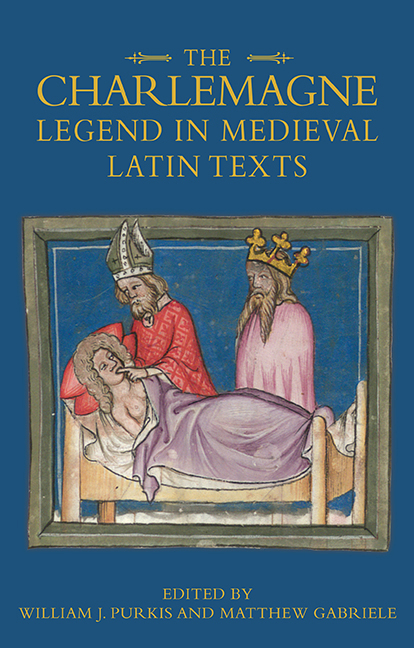Book contents
- Frontmatter
- Dedication
- Contents
- List of Illustrations
- Contributors
- General preface Charlemagne: A European Icon
- Acknowledgements
- List of Abbreviations
- Introduction The Many Latin Lives of Charlemagne
- 1. Frankish Kingship, Political Exegesis and the Ghost of Charlemagne in the Diplomas of King Philip I of Francia
- 2. The Twelfth-Century Vita Karoli and the Making of a Royal Saint
- 3. Performing Sacrality: The Liturgical Portrait of Frederick Barbarossa's Charlemagne
- 4. Rex Parvus or Rex Nobilis? Charlemagne and the Politics of History (and Crusading) in Thirteenth-Century Iberia
- 5. Charlemagne in Girona: Liturgy, Legend and the Memory of Siege
- 6. ‘For the Honour of the Blessed Virgin’: The History and Legacy of Charles's Devotion to Mary in the Gesta Karoli Magni ad Carcassonam et Narbonam
- 7. Charlemagne the Sinner: Charles the Great as Avatar of the Modern in Petrarch's Familiares 1.4
- 8. The Quattrocento Charlemagne: Franco–Florentine Relations and the Politics of an Icon
- Index
- Miscellaneous Endmatter
5. - Charlemagne in Girona: Liturgy, Legend and the Memory of Siege
Published online by Cambridge University Press: 25 October 2017
- Frontmatter
- Dedication
- Contents
- List of Illustrations
- Contributors
- General preface Charlemagne: A European Icon
- Acknowledgements
- List of Abbreviations
- Introduction The Many Latin Lives of Charlemagne
- 1. Frankish Kingship, Political Exegesis and the Ghost of Charlemagne in the Diplomas of King Philip I of Francia
- 2. The Twelfth-Century Vita Karoli and the Making of a Royal Saint
- 3. Performing Sacrality: The Liturgical Portrait of Frederick Barbarossa's Charlemagne
- 4. Rex Parvus or Rex Nobilis? Charlemagne and the Politics of History (and Crusading) in Thirteenth-Century Iberia
- 5. Charlemagne in Girona: Liturgy, Legend and the Memory of Siege
- 6. ‘For the Honour of the Blessed Virgin’: The History and Legacy of Charles's Devotion to Mary in the Gesta Karoli Magni ad Carcassonam et Narbonam
- 7. Charlemagne the Sinner: Charles the Great as Avatar of the Modern in Petrarch's Familiares 1.4
- 8. The Quattrocento Charlemagne: Franco–Florentine Relations and the Politics of an Icon
- Index
- Miscellaneous Endmatter
Summary
FOR centuries, residents of the city of Girona in northeastern Spain have fostered a legend that Charlemagne personally conquered their city from the Muslims in 785. Even today, Charlemagne retains a significant presence in Girona: among several Carolingian-themed curiosities, the Catalan city boasts a ‘Torre de Carlemany’, an eleventhcentury Romanesque bell tower of the city's cathedral; a ‘Cadira de Carlemany’, an episcopal throne carved out of marble that apparently looked so old the emperor himself could have used it; and a ‘Cartoral de Carlemany’, an early thirteenth-century cartulary. For tourists, there is also a Hotel Carlemany in a downtown plaza. The tradition of Charlemagne's conquest of Girona has murky origins, but has enjoyed a long life in the city. In fact, it was so popular that from 1345 until at least 1484 Charlemagne was not just a conquering folk hero remembered in local legend, but also a liturgically celebrated saint in the diocese. For the centrepiece of this celebration, Arnau de Mont-rodon, canon of the cathedral (1313–35) and then bishop of Girona (1335–48), directed the creation of a unique corpus of Latin liturgical texts, including the Officium in festo sancti Karoli magni imperatoris et confessoris, the Legenda sancti Karoli Magni and the Tractatus de captione Gerunde, that each lauded Charlemagne's founding of local churches, including the cathedral, as well as his heroic, miraculous and entirely fabricated capture of the city.
Scholars such as Gaston Paris, F. E. Schneegans and Jules Coulet have traced the liturgical narrative of the taking of Girona to a number of written sources, including the puzzling ‘Fragment de la Haye’, the twelfth-century Chronicon Rivipullensis and Historia Turpini (Pseudo- Turpin) and, most notably, the thirteenth-century Gesta Karoli Magni ad Carcassonam et Narbonam (Pseudo-Philomena) composed at Lagrasse. These connections, largely based on names and locations shared between the texts, are convincing. Miquel Coll i Alentorn also found compelling hints that Arnau de Mont-rodon may have considered elements of the 1285 French campaign against Girona during the crusade against Aragon, noting similar references to ships and supply lines in the fourteenth-century liturgical texts and the slightly earlier Catalan chronicles of the crusade by Bernat Desclot and Ramon Muntaner.
- Type
- Chapter
- Information
- The Charlemagne Legend in Medieval Latin Texts , pp. 115 - 147Publisher: Boydell & BrewerPrint publication year: 2016

